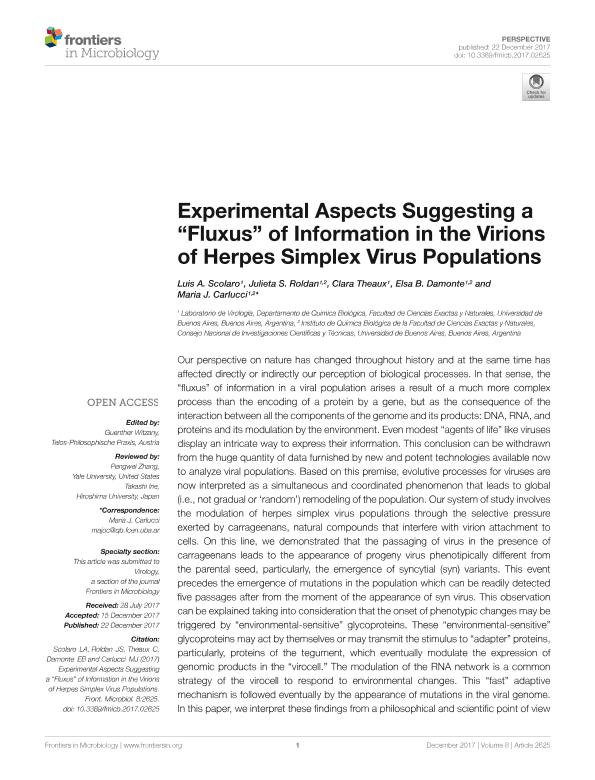Mostrar el registro sencillo del ítem
dc.contributor.author
Scolaro, Luis Alberto

dc.contributor.author
Roldan, Julieta Suyay

dc.contributor.author
Theaux, Clara

dc.contributor.author
Damonte, Elsa Beatriz

dc.contributor.author
Carlucci, Maria Josefina

dc.date.available
2018-07-13T19:05:01Z
dc.date.issued
2017-12
dc.identifier.citation
Scolaro, Luis Alberto; Roldan, Julieta Suyay; Theaux, Clara; Damonte, Elsa Beatriz; Carlucci, Maria Josefina; Experimental aspects suggesting a "fluxus" of information in the virions of herpes simplex virus populations; Frontiers Research Foundation; Frontiers in Microbiology; 8; DEC; 12-2017; 1-6
dc.identifier.issn
1664-302X
dc.identifier.uri
http://hdl.handle.net/11336/52080
dc.description.abstract
Our perspective on nature has changed throughout history and at the same time has affected directly or indirectly our perception of biological processes. In that sense, the "fluxus" of information in a viral population arises a result of a much more complex process than the encoding of a protein by a gene, but as the consequence of the interaction between all the components of the genome and its products: DNA, RNA, and proteins and its modulation by the environment. Even modest "agents of life" like viruses display an intricate way to express their information. This conclusion can be withdrawn from the huge quantity of data furnished by new and potent technologies available now to analyze viral populations. Based on this premise, evolutive processes for viruses are now interpreted as a simultaneous and coordinated phenomenon that leads to global (i.e., not gradual or 'random') remodeling of the population. Our system of study involves the modulation of herpes simplex virus populations through the selective pressure exerted by carrageenans, natural compounds that interfere with virion attachment to cells. On this line, we demonstrated that the passaging of virus in the presence of carrageenans leads to the appearance of progeny virus phenotipically different from the parental seed, particularly, the emergence of syncytial (syn) variants. This event precedes the emergence of mutations in the population which can be readily detected five passages after from the moment of the appearance of syn virus. This observation can be explained taking into consideration that the onset of phenotypic changes may be triggered by "environmental-sensitive" glycoproteins. These "environmental-sensitive" glycoproteins may act by themselves or may transmit the stimulus to "adapter" proteins, particularly, proteins of the tegument, which eventually modulate the expression of genomic products in the "virocell." The modulation of the RNA network is a common strategy of the virocell to respond to environmental changes. This "fast" adaptive mechanism is followed eventually by the appearance of mutations in the viral genome. In this paper, we interpret these findings from a philosophical and scientific point of view interconnecting epigenetic action, exerted by carragenans from early RNA network-DNA interaction to late DNA mutation. The complexity of HSV virion structure is an adequate platform to envision new studies on this topic that may be complemented in a near future through the analysis of the genetic dynamics of HSV populations.
dc.format
application/pdf
dc.language.iso
eng
dc.publisher
Frontiers Research Foundation

dc.rights
info:eu-repo/semantics/openAccess
dc.rights.uri
https://creativecommons.org/licenses/by/2.5/ar/
dc.subject
CARRAGEENANS
dc.subject
EPIGENETIC
dc.subject
HERPES SIMPLEX VIRUS
dc.subject
MICRORNAS
dc.subject
NON-CODING RNAS
dc.subject
REGULATORY NETWORKS
dc.subject
VIRAL POPULATION
dc.subject
VIRUS-HOST INTERACTIONS
dc.subject.classification
Otras Ciencias Biológicas

dc.subject.classification
Ciencias Biológicas

dc.subject.classification
CIENCIAS NATURALES Y EXACTAS

dc.title
Experimental aspects suggesting a "fluxus" of information in the virions of herpes simplex virus populations
dc.type
info:eu-repo/semantics/article
dc.type
info:ar-repo/semantics/artículo
dc.type
info:eu-repo/semantics/publishedVersion
dc.date.updated
2018-07-11T15:03:44Z
dc.journal.volume
8
dc.journal.number
DEC
dc.journal.pagination
1-6
dc.journal.pais
Suiza

dc.description.fil
Fil: Scolaro, Luis Alberto. Universidad de Buenos Aires. Facultad de Ciencias Exactas y Naturales. Departamento de Química Biológica. Laboratorio de Virología; Argentina. Consejo Nacional de Investigaciones Científicas y Técnicas; Argentina
dc.description.fil
Fil: Roldan, Julieta Suyay. Consejo Nacional de Investigaciones Científicas y Técnicas. Oficina de Coordinación Administrativa Ciudad Universitaria. Instituto de Química Biológica de la Facultad de Ciencias Exactas y Naturales. Universidad de Buenos Aires. Facultad de Ciencias Exactas y Naturales. Instituto de Química Biológica de la Facultad de Ciencias Exactas y Naturales; Argentina
dc.description.fil
Fil: Theaux, Clara. Universidad de Buenos Aires. Facultad de Ciencias Exactas y Naturales. Departamento de Química Biológica. Laboratorio de Virología; Argentina
dc.description.fil
Fil: Damonte, Elsa Beatriz. Consejo Nacional de Investigaciones Científicas y Técnicas. Oficina de Coordinación Administrativa Ciudad Universitaria. Instituto de Química Biológica de la Facultad de Ciencias Exactas y Naturales. Universidad de Buenos Aires. Facultad de Ciencias Exactas y Naturales. Instituto de Química Biológica de la Facultad de Ciencias Exactas y Naturales; Argentina
dc.description.fil
Fil: Carlucci, Maria Josefina. Consejo Nacional de Investigaciones Científicas y Técnicas. Oficina de Coordinación Administrativa Ciudad Universitaria. Instituto de Química Biológica de la Facultad de Ciencias Exactas y Naturales. Universidad de Buenos Aires. Facultad de Ciencias Exactas y Naturales. Instituto de Química Biológica de la Facultad de Ciencias Exactas y Naturales; Argentina
dc.journal.title
Frontiers in Microbiology
dc.relation.alternativeid
info:eu-repo/semantics/altIdentifier/doi/http://dx.doi.org/10.3389/fmicb.2017.02625
dc.relation.alternativeid
info:eu-repo/semantics/altIdentifier/url/https://www.frontiersin.org/articles/10.3389/fmicb.2017.02625/full
Archivos asociados
